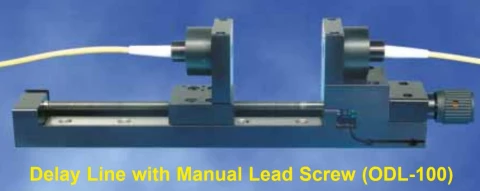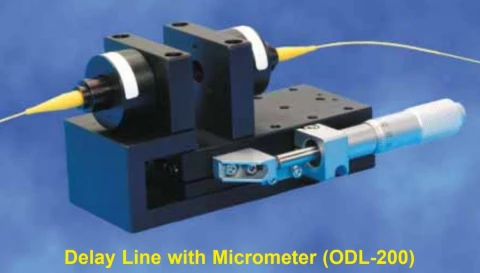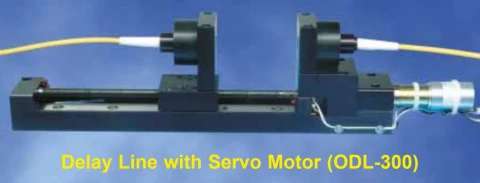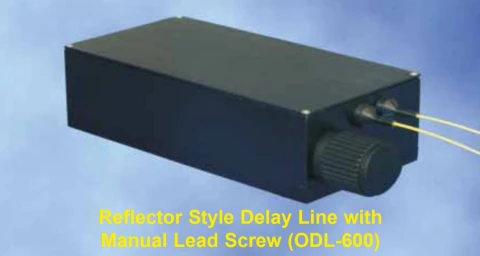Description
The Optical Delay Lines (ODL) provide precise control over the delay time of light signals. They consist of input and output fiber collimators that project the light into free space and collect it back into a fiber. The delay time can be controlled by adjusting the separation between the input and output optics or by reflecting the light off a movable reflector.
With sub-picosecond resolution and a wide wavelength range, these delay lines are ideal for various applications in high-speed communications networks, interferometric sensors, coherent telecommunications, spectrum analyzers, and OCT systems.
Optical Delay Lines with Sub-Picosecond Resolution
Specifications
| Travel Range: | 50 mm |
|---|---|
| Resolution: | 635 um |
| Delay Range: | 167 psec |
| Delay Resolution: | 2 psec |
| Return Loss: | 60 dB |
| Insertion Loss: | <1.1 dB |
| Size: | 132.5x50.8x30.2 mm |
| Fiber Type: | PM/SM |
| Wavelength Range: | 400–2000 nm |
| Delay Adjustment Method: | Reflector style, manual |
Features
- Low insertion loss
- Sub-picosecond resolution
- Wide wavelength range (400–2000 nm)
- Over 600 picoseconds delay range (NEW)
- Polarization insensitive
- Singlemode and polarization maintaining fiber versions available
- Electrically controlled versions available
- Miniature style version
Applications
- PMD compensation in high-speed communications networks
- Interferometric sensors
- Coherent telecommunications
- Spectrum analyzers
- OCT systems
Frequently Asked Questions
What are Optical Delay Lines?
Optical Delay Lines (ODL) are devices that provide precise control over the delay time of light signals.
What is the range of delay time that can be controlled by ODL?
ODL can control delay time with sub-picosecond resolution and over 600 picoseconds delay range.
What are the applications of ODL?
ODL is ideal for various applications in high-speed communications networks, interferometric sensors, coherent telecommunications, spectrum analyzers, and OCT systems.
What types of fibers are used in ODL?
ODL is offered using singlemode, multimode or Polarization Maintaining (PM) fibers.
How are the delay lines controlled in ODL?
Delay lines are offered in both manual or electrically controlled versions. Electrically controlled versions utilize a servo motor with encoders to monitor the motion and can be easily controlled by a computer via an RS-232 interface or manually using some simple TTL input signals.
Thank You!
Your inquiry has been received.
Create an account by adding a password
Why create an account?
- Auto-complete inquiry forms
- View and manage all your past messages
- Save products to your favorites
- Close your account anytime — no hassle



